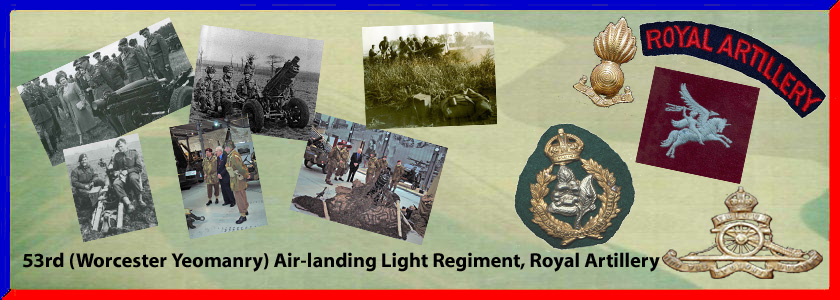[Home] [Events] [Links] [Guestbook] [Contact Us]
1st Independent Polish Parachute Brigade
53rd (Worcester Yeomanry) Air landing Light Regt., Royal Artillery
Operation: Overlord. D-Day, 6th June 1944
An Airborne Light Regt required 80 Horsa gliders – one gun and Jeep per glider, with accompanying Hamilcars for ammunition supply. Owing to a shortage of gliders, only 211 Battery could take part in the assault on D Day together with the 6th Airborne Division.
211 Battery was tasked to seize and hold the high wooded area behind Caen on the eastern flank of the Normandy bridgehead. 211 battery, accordingly under the command of Major Craigie, landed near Caen in 27 gliders on June 6th - the first British Field Battery ever to have flown into action against an enemy. 210 and 212 Batteries landed by sea at Colleville-sur-Orme on June 14th 1944 (D Day +8).
The regiment was also called upon to man a wide series of Forward Observation Posts, providing locating information for the Parachute and Special Brigades targeting German mortar positions. During the arduous advance that was Operation PADDLE, enemy minefields, numerous snipers and machine-gun positions slowed progress but determined action brought the regiment to a rest area near Honfleur on August 27th 1944, the conclusion of the Regiments campaign in Normandy having acted as Divisional artillery for nearly 3 months. Casualties were considered light overall. The Regiment, however, had 3 officers and 15 NCOs and Other Ranks killed.
In October 1944, a service of remembrance and thanksgiving was conducted by the Very Reverend Dean Davies in Worcester Cathedral, whilst Lt. Col. Teacher laid a wreath in memory of the officers and men who had fallen in Normandy.
On December 20th 1944, the regiment received orders to proceed overseas again and by Boxing Day of that year they were in action near Dinant in support of the 6th Air-landing Brigade as the British defended a successful German offensive in the Ardennes. Hitler's last throw was repulsed eventually and the again retreating Germans were pursued by the Allies with the regiment providing Forward Observation Officers in the snow. 210 Battery claimed to be the first to land shells on German soil. On January 30th 1945, Lt. Col. Eden, DSO, took over command of the regiment after which the regiment was withdrawn back to England on February 20th 1945.
Operation: Varsity / Plunder. 24th March 1945
Lessons were learnt from not only from Normandy, but also Operation MARKET GARDEN, where in the previous September the British 1 Airborne Division had suffered greatly as a result of a dropping and landing with separate 3 lifts.
Operation VARSITY was the airborne element of the Rhine Crossing. Operation PLUNDER was the ground operation. However, gliders were again in short supply necessitating that 210 Battery was split between 211 and 212.
On March 24th 1944, 78 gliders set off from England following a successful night attack that had established bridgeheads on the German eastern bank of the Rhine. The regiment’s first guns were in action within 10 minutes of the gliders landing on the landing zone in the vicinity of Hammilkeln .
Unfortunately, the landing – at 1000hrs - was costly and 22 of the regiment’s gliders were destroyed either on landing or in the air. This emphasized that the most dangerous part of an airborne landing can be the arrival by glider. Only half of the Regiments guns were immediately available, however, and ammunition limited. The Hamilcar glider bring the bulk of the Regiments ammunition had crashed wide of the Landing Zone. The Commanding Officer, Lt. Col. Eden, led a daring raid to recover the ammunition, but this was unsuccessful, requiring a second, undercover of darkness, and with infantry support, to acquire sufficient 75mm shells. By the evening all of the Divisions objectives had been taken, and 15 (Scottish) Infantry Division were in contact. By this time however 2 Battery Commanders and 20 Other Ranks had been killed, with 8 officers and 59 men missing or prisoners of war.
NEXT ... The March to the Sea: March to May 1945


